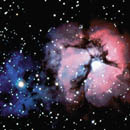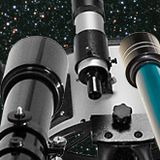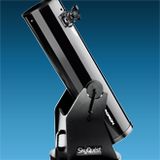
Galaxies
When you observe a galaxy, you're looking beyond the boundaries of our own Milky Way galaxy at a colossal stellar system millions of light years away. Spiral galaxies feature a central bulge of old stars surrounded by spiral arms containing younger stars and laced with gas and dust. Barred-spiral galaxies have an obvious central "bar" of material. Spirals are further classified as Sa, Sb, Sc, Sd, or Sm (or SBa, SBb, etc. for barred spirals) according to how tightly their arms are wound, with Sa being the tightest and Sm the loosest. Intermediate classifications are designated by ab, bc, and so on. SO galaxies are poorly defined spirals with bright disks but no discernible arms. Sp galaxies are peculiar spirals that don?t fit the standard profiles. Elliptical galaxies are armless masses of elderly stars. They vary from nearly spherical (E0) to highly flattened (E7). Irregular galaxies show no symmetry, exhibiting odd or chaotic structures. So-called peculiar galaxies do not fall into any of the above classifications.
Galaxies are tilted at different angles to our line of sight, from edge-on to face-on. The sense of dimensionality adds to the enjoyment of viewing galaxies. Note that the magnitude listed for galaxies or other "extended" objects can be deceiving. It represents overall light output; however, the light is spread out over an area of sky, reducing the object?s surface brightness. Thus, an 8th-magnitude galaxy will appear fainter than an 8th-magnitude star, whose light is concentrated at a single point.
 Nebulas
Nebulas
Ghostly clouds of gas and dust, nebulas reside in the spiral arms of our galaxy. Emission nebulas shine on their own, as intense ultraviolet radiation from nearby stars excites hydrogen gas, causing it to fluoresce. Reflection nebulas do not glow; tiny dust particles merely reflect the light emitted by nearby stars. Dark nebulas consist of cold dust and gas that absorb or scatter starlight. We infer their presence by the absence of light visible behind them. Planetary nebulas (PN) are the expelled shells of aging stars. They appear as small, bright disks. Although planetaries usually have a high surface brightness, their faint central stars can be difficult or impossible to detect in small instruments. The remains of more violent stellar explosions are called supernova remnants.
Star Clusters
Stars congregate in two different types of clusters: open and globular. Open clusters, also called galactic clusters, contain from a few to upwards of 100 young stars born from a common cloud of hydrogen gas and cosmic dust. These loose groupings, held together gravitationally, are found mostly in the Milky Way band. Many open clusters are best viewed with low power, making excellent targets for binoculars. Globular clusters are quite different, and more challenging to observe. They are tightly packed balls of thousands or hundreds of thousands of older stars that lie in a halo around the central hub of our galaxy. Part of the fun of observing globular clusters, as well as the challenge, is in trying to resolve individual stars. This is easier to do for the larger and less condensed globulars. Larger telescope apertures also help. Stars on the fringes of the cluster will resolve first. Asterisms are not clusters per se, but distinctive patterns of unassociated stars.
Double and Multiple Stars
Although most stars may appear to be single, the majority actually consist of two or more stars bound together gravitationally, orbiting around a common center of gravity. Some of these binary star systems can be separated into their component stars with a small telescope, revealing beautiful color and magnitude contrasts as well as varying degrees of separation. Optical doubles are not physically associated; these stars appear close together in the sky only because they lie along the same line of sight. Observing double stars requires a still atmosphere (good "seeing"), especially when trying to split very close doubles using high magnification. Large apertures will resolve more doubles than small apertures. Defocusing the stars a bit can accentuate their colors.
Variable Stars
Variable stars change in brightness over time. Estimating a variable star's magnitude at various time points and plotting its "light curve" is a worthwhile activity. To accurately estimate the magnitude, you must compare the variable to stars of known, fixed magnitude, preferably in the same field of view. Exact star magnitudes can be found in a star catalog or on special variable star charts.
Long-period variables, known as Mira-type variables after the prototype Omicron (o) Ceti, or Mira, in Cetus, are pulsating red giants whose magnitude varies over several months. The light fluctuations differ in duration and amplitude with each cycle. Cepheid variables, named after the prototype Delta Cephei, in the constellation Cepheus, exhibit very regular and precise brightness fluctuations ranging from one day to several days. A Cepheid's period (the time it takes to cycle from maximum brightness to minimum and back to maximum again) and its intrinsic luminosity are directly related: the longer the period, the more luminous the star. RR Lyrae variables have short, regular periods of less than one day. Irregular variables have unpredictable periods. Eruptive variables are stars whose brightness changes irregularly and often suddenly. R Coronae Borealis stars are in this class; they exhibit occasional sudden drops in magnitude. RV Tauri variables are pulsating supergiants with alternating primary and secondary minimum magnitudes. Eclipsing variables are really binary pairs of steady-shining stars that orbit each other edge-on to our vantage point. Periodically, one member of the pair passes in front of the other, temporarily blocking its light. Algol, in the constellation Perseus, is a classic example of an eclipsing variable.



















